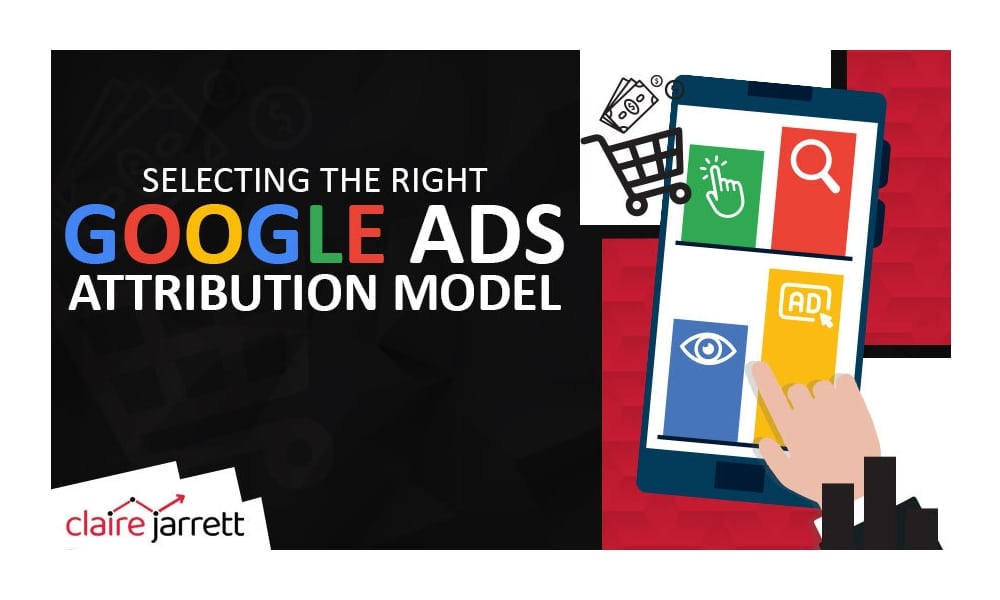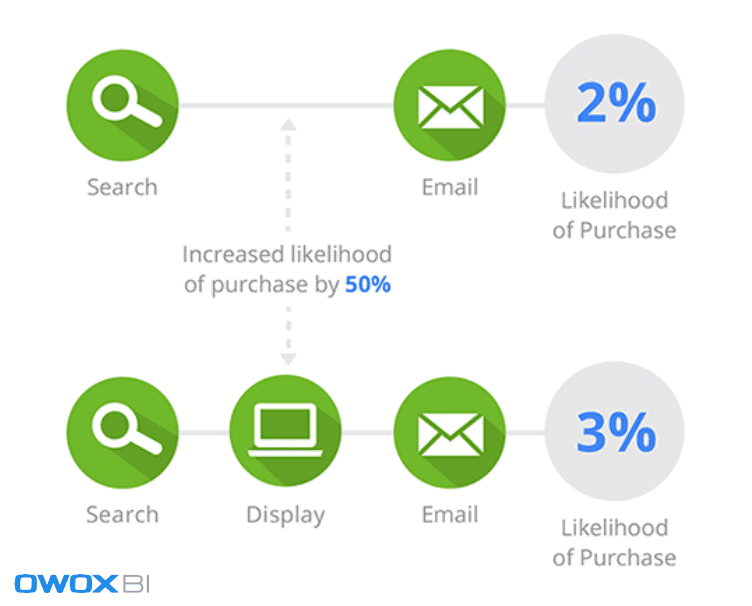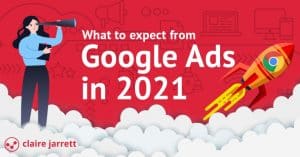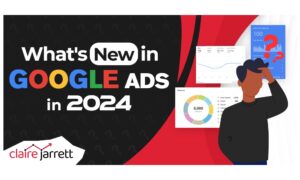How To Select the Right Google Ads Attribution Model

Last Updated on: 7th February 2025, 04:08 pm
If a lead turned into a customer and interacted with you multiple times, which final touchpoint caused them to make the purchase? That’s what attribution modelling is all about.
In this article you’ll learn you how to select the best attribution model for your advertising strategy. Let’s jump into it.
How Does Attribution Modelling Work?
Leads take a whole journey on their way to becoming your customers (i.e., the customer journey). From first spotting you on social media and receiving your emails to converting on your remarketing ads, there are a plethora of touchpoints they go through, only to convert through their last.
However, just because they clicked on a button at the last touchpoint doesn’t mean you have to credit all the conversions to it.
For example, if your last step was an email sequence and prior to that you had 2-3 Google Ads campaigns, would you say they were unsuccessful?
No. They contributed to the conversion.
Attribution modelling determines how credit for conversions should be assigned to various touchpoints in the journey. Practically, it will help you see which channels contribute to conversions the most.
How Does Google Ads Approach Attribution Modelling?
If you run multiple Google Ads campaigns for different stages of the funnel (e.g., you have Demand Gen campaigns for unaware audiences, Performance Max for leads at the middle of the funnel looking for solutions, and campaigns targeting competitors’ branded keywords for purchase-ready leads), Google Ads offers two attribution models.
After all, it takes multiple touchpoints for conversions to happen. Every campaign in your toolbox plays a role.
Your mission is to understand just how big their roles are.
Types of Google Ads Attribution Models in 2025
In the past, Google offered numerous models, including first-click, linear, time decay, and position-based models. However, it started retiring these models in 2023. This came as a bit of a shock.
For example, the linear attribution model would allow you to distribute even credit to each touchpoint (e.g., each campaign out of 4 would get a 25% share).
Similarly, if you believed your first campaigns were the strongest, you would have given most of the credit to the first campaign in the sequence.
Nevertheless, Google Ads attribution models now boil down to only two:
1. The Last-Click Google Ads Attribution Model
The last-click Google Ads attribution model gives all credit for the conversion to the ad the leads last clicked on.
For example, suppose you’re a doctor advertising your medical practice and want to use the last-click Google Ads attribution model.
A potential patient whom we’ll call Sarah starts experiencing symptoms and searches for information online. She clicks on your ad that discusses possible causes.
After reading the article, Sarah decides to do further research. She conducts another search for local doctors specialising in her condition. She clicks on a Google Ads ad promoting your practice.
When she reviews the information on your website, Sarah decides to schedule an appointment. She clicks the CTA and fills out the form. She arrives for her appointment and becomes a patient (converts).
In this scenario, the last-click attribution model would attribute the entire credit for Sarah’s conversion (booking an appointment) to the last interaction – clicking on the Google ad for your practice.

The Pros and Cons of the Last-Click Attribution Model
Now, last-click attribution is a simple way to measure the impact of ads on your conversions. However, it fails to account for other touchpoints earlier in the customer journey. This would be fine if you were only running one campaign. But if you are running multiple, it becomes an issue.
The last-click Google Ads attribution model can also make you overvalue channels that are only a part of the journey.
For example, if you were not an experienced Google Ads practitioner, you could easily eliminate your first campaign and experience a conversion drop because the first ad was crucial.
2. Data-Driven Attribution in Google Ads
The data-driven Google Ads attribution model is another foray into machine learning and Artificial Intelligence. But unlike ChatGPT, Google’s AI uses historical data to determine which touchpoints should get the most credit.
Google’s algorithms identify patterns and relationships between different touchpoints and conversions. They look at several factors, including:
- The sequence of interactions (For example, the customer is first exposed through a Google Shopping ad, engages with it extensively, but ultimately converts through a remarketing ad)
- The timing of each interaction (E.g., looking for a winter clothing item in December and seeing a remarketing banner ad two weeks later)
- Channel type (E.g., they first see a Search ad, but they see a YouTube ad later which prompts the conversion)
- Converting users’ behaviour (E.g., the customers spend a lot of time performing research-related queries, and they look for landing pages with explainer videos)
If you’re saying: “But Claire, doesn’t all of this sound vague?”, I don’t blame you!
Google, with its latest push toward AI, is turning the ad platform into a black box. Make sure you know your customer journey inside and out to control if Google is attributing conversions accurately.
For example, suppose you’re selling electronics online. You’re running YouTube, Discovery, and Search ads.
First, Google’s algorithms would look at YouTube KPIs like view-through conversions (users who saw the ad and later converted without clicking) and click-through conversions (users who clicked on the ad and then converted), as well as video views, watch time, and interaction rates.
Then, they’d evaluate Display metrics such as impressions, clicks, and conversion rates to determine their impact on customers’ actions.
Finally, they’d look at search ad KPIs like clicks, impressions, click-through rates (CTR), and conversion rates.
Needless to say, for all of these you’d need to have conversion tracking configured properly. Otherwise, it’s a moot point.
The data-driven model then assigns credit to each touchpoint based on its actual contribution to driving conversions. It considers the sequence and timing of interactions for added context, and calculates conversion probability.

The Pros and Cons of the Data-Driven Google Ads Attribution Model
If you have multiple campaigns, you can’t do without the data-driven model. However, there is the black-box issue.
While Google’s algorithms have access to vast data, they don’t have the entrepreneurial context that you have. That’s why I always suggest taking the AI/ML suggestions with a grain of salt and doing your own research.
Don’t turn to Google for advice about your audience. If anything, it should turn to you.
How to Choose (and Set up) the Right Attribution Model
With many of the attribution models no longer available in 2025, the last-click attribution model is a simple choice for getting started, and the data-driven is a more complex process that’s more sustainable in the long term.
When and How to Use the Last-Click Attribution Model in Google Ads
Choose the last-click attribution if your campaigns follow a linear customer journey. Ideally, you would have tested your conversion hypotheses in the past and can now re-validate them with this model.
To set up the last-click attribution, follow the steps:
- Click on “Tools & Settings” in your Google Ads account
- Go to Measurement -> Attribution
- Choose the attribution model
- Click “Save”
Keep in mind that you will need to set up conversion actions before that. You can also set attribution at the conversion action or campaign level.
In your reports, you can toggle between different models, paths, and journeys to get a sense of how different ads play into your ultimate conversions.
Two Challenges with Google’s Attribution Modelling
Finally, Google Ads isn’t a perfect platform. There are two things to be aware of before you lean on attribution modelling:
Cross-Device Tracking Is an Issue for Google Ads Attribution Models
With so many people using multiple devices, it’s difficult to track the customer journey accurately. For example, a customer might see your ad on their phone, but then make a purchase on their laptop.
To overcome this challenge, you can use cross-device tracking with Google Analytics. It’s as close as you can come to seeing the full picture in the privacy era.
Using More Channels than Just Google Ads?
With so many different channels, it’s hard to know which ones drive the most conversions. For example, a customer might see your ad on Google, click through to your website, and finally purchase your product after seeing your ad on Facebook.
Use multi-channel funnels in Google Analytics, connected with Google Ads, to get a better understanding. You can also use third-party and server-side tracking tools like RedTrack to see how Google Ads impact your entire marketing.
The Future of Attribution Modelling
When I look at the past of Google Ads, it’s quite easy to spot two big trends: privacy and AI. Expect more AI/ML additions to the platform like data-driven tracking to allow Google to harness more information and use it in advertising without sharing the data directly with you and compromising the searchers’ privacy.
If you haven’t started experimenting with attribution modelling on Google Ads, I recommend starting as soon as possible. First, make sure you’re setting up your campaigns for success with my best-selling Google Ads book.
Then, move forward bravely! Iteration over perfection, as they say.
Of course, if you’d like to get a headstart, contact my team and me for a tailored Google Ads plan that generated millions of pounds in additional revenue.






